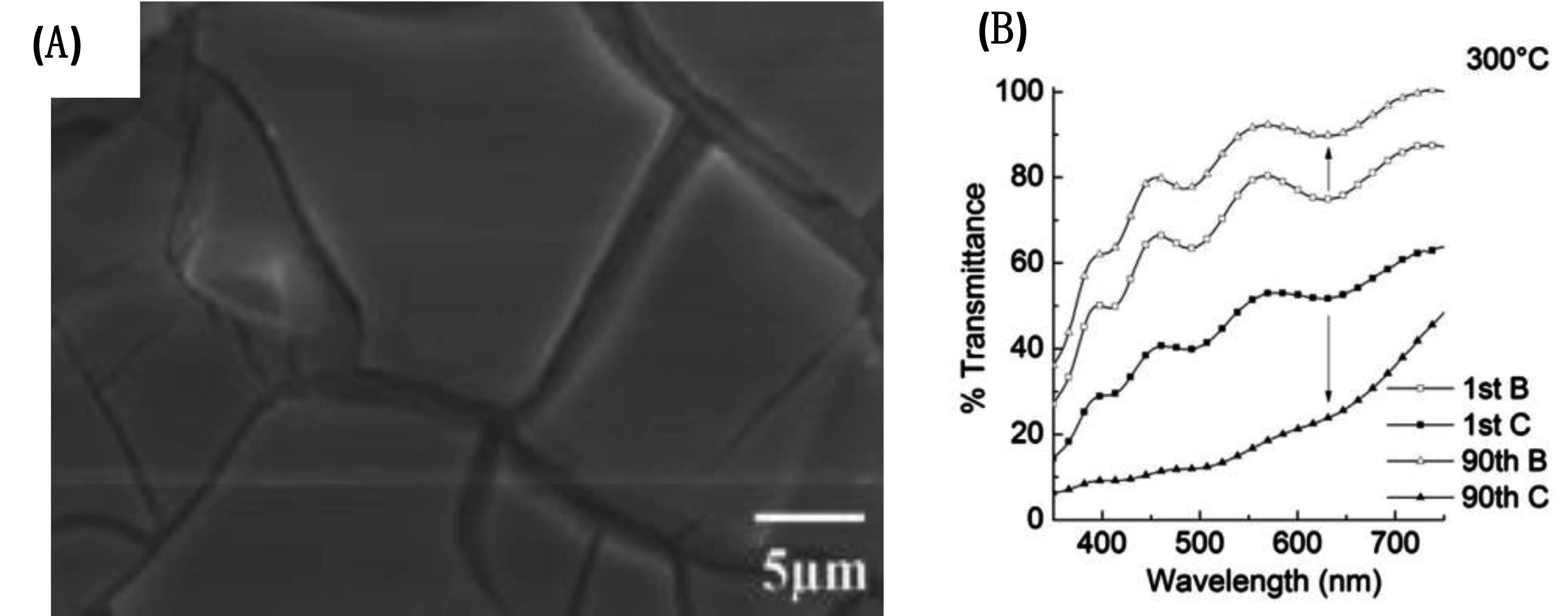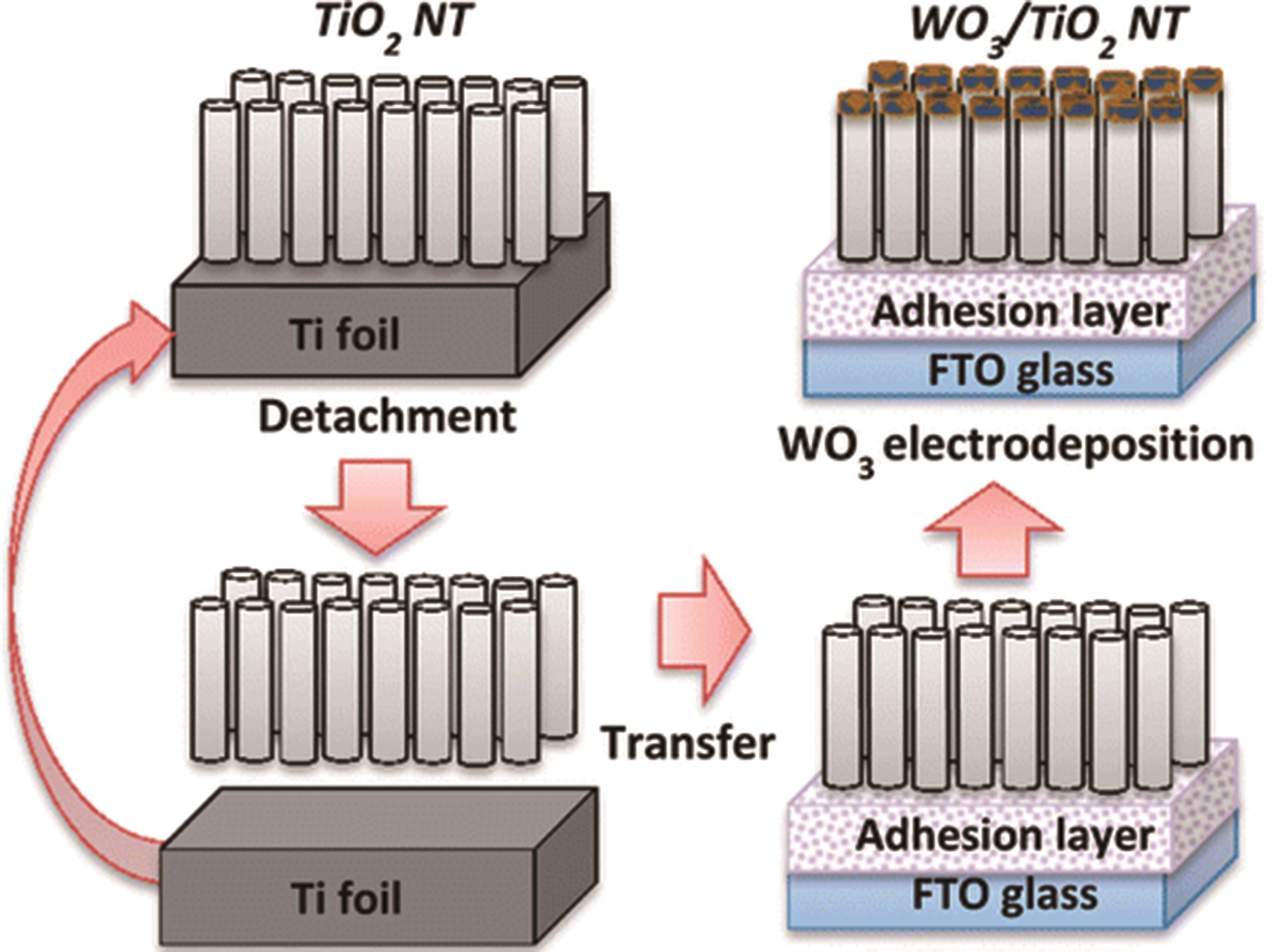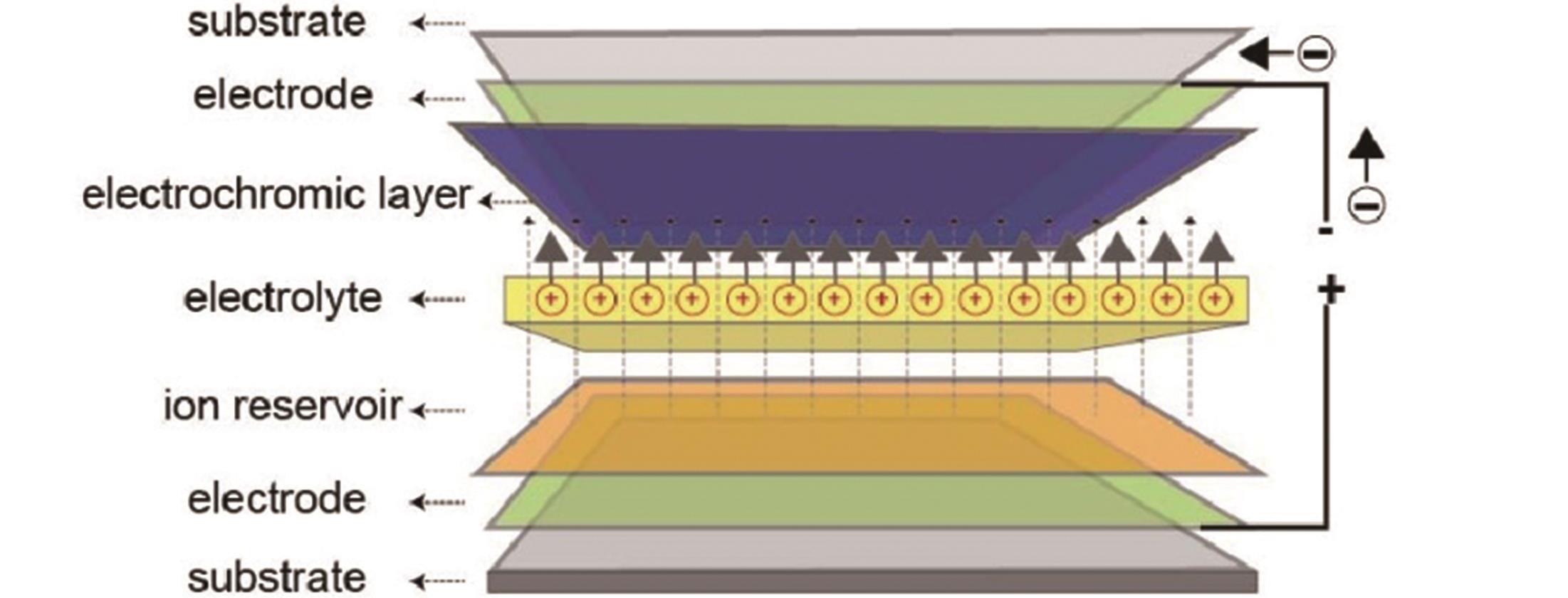
应用化学 ›› 2022, Vol. 39 ›› Issue (9): 1345-1359.DOI: 10.19894/j.issn.1000-0518.220049
无机-无机复合电致变色材料的研究进展
- 中国海洋大学材料科学与工程学院,青岛 266100
-
收稿日期:2022-02-25接受日期:2022-05-31出版日期:2022-09-01发布日期:2022-09-08 -
通讯作者:苏革 -
作者简介:第一联系人:共同第一作者 -
基金资助:国家自然科学基金(21775142)
Advances of Inorganic‑inorganic Composite Electrochromic Films
Xin GU, Wen-Qing WANG, Jun-He HOU, Lu GAO, Ming-Hua HUANG, Ge SU( )
)
- School of Materials Science and Engineering,Ocean University of China,Qingdao 266100,China
-
Received:2022-02-25Accepted:2022-05-31Published:2022-09-01Online:2022-09-08 -
Contact:Ge SU -
About author:gesu@ouc.edu.cn
-
Supported by:the Natural Science Foundation of China(21775142)
摘要:
在外加电压的作用下,电致变色材料的光学性能(颜色、透光率等)能够可控制、可逆地变化,在节能减排领域有重要应用前景。随着相关研究的不断创新、深入和拓展,单一组分的电致变色材料因受到其自身结构和性能的限制,不能表现出人们所期望的电致变色性能,并且在结构和性能上不具有可设计和调控性,因而越来越无法满足实际应用的需求。与非复合电致变色材料相比较,复合型材料在这方面具有明显的优势,其优势体现在通过合理的材料设计,借助复合材料各组分的协调作用,充分激发各组分的优点,克服各自的缺点,可以获得结构和性能优异的电致变色材料。因此,近年来越来越多的研究聚焦于复合型电致变色材料。目前已开展研究的复合型电致变色材料的种类很多,根据复合组分是无机材料还是有机材料来对复合型电致变色材料分类的话主要可分为无机-无机复合、无机-有机复合和有机-有机复合3大类。相比有机电致变色材料,无机电致变色材料在材料成分控制、机械性能、光调制、使用稳定性、寿命等方面优势显著,因此,单一组分的和复合型的无机电致变色材料始终是本领域研究的重要方向。因此,本文致力于近年来无机-无机复合电致变色材料、器件和电解质的研究现状和未来的发展动态,对其研究进展、所存在的问题和发展趋势进行了归纳总结,为复合型电致变色材料的进一步研发和应用提供依据。
中图分类号:
引用本文
谷欣, 王文庆, 侯钧贺, 高露, 黄明华, 苏革. 无机-无机复合电致变色材料的研究进展[J]. 应用化学, 2022, 39(9): 1345-1359.
Xin GU, Wen-Qing WANG, Jun-He HOU, Lu GAO, Ming-Hua HUANG, Ge SU. Advances of Inorganic‑inorganic Composite Electrochromic Films[J]. Chinese Journal of Applied Chemistry, 2022, 39(9): 1345-1359.
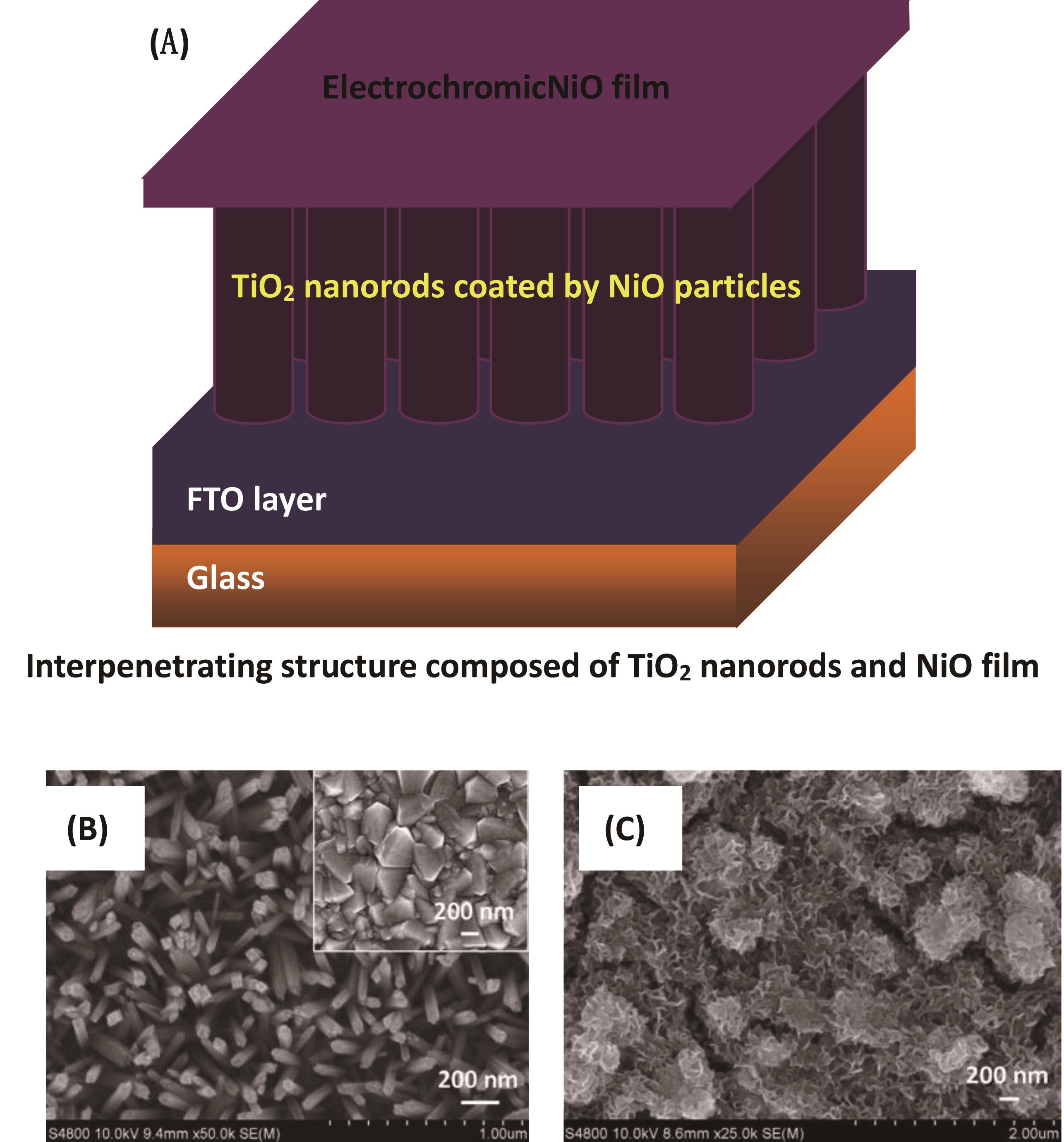
图3 (A)穿插型复合结构NiO-TiO2薄膜的结构示意图; (B) TiO2纳米棒阵列的SEM照片,插图为FTO的表面形貌SEM照片; (C) NiO-TiO2复合薄膜的SEM照片[34]
Fig.3 (A) Structure diagram of the NiO-TiO2 film with interpenetrating composite structure; (B) SEM image of TiO2 nanorod array, the inset picture is the SEM image of the FTO substrate; (C) SEM image of NiO-TiO2 composite film[34]
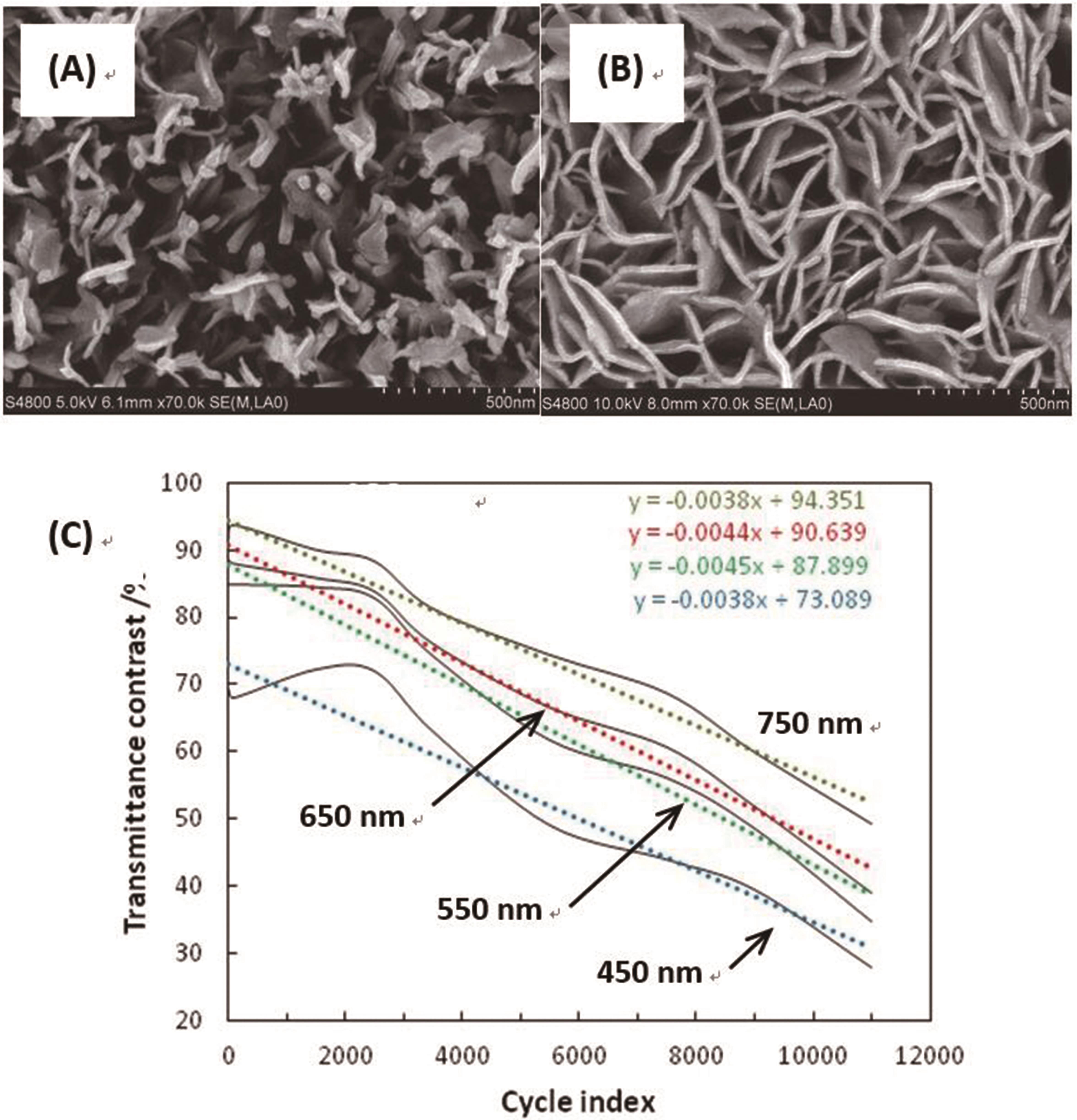
图4 Ni(OH)2在TiO2纳米棒阵列上沉积135 min (A)和360 min (B)所制备的Ni(OH)2-TiO2复合膜的SEM形貌照片; 图B中的复合膜在不同波长处的光调制与变色循环次数的关系曲线(C),其中实线为测试数据,点线为拟合值[39]
Fig.4 SEM images of Ni(OH)2-TiO2 composite films prepared by deposition of Ni(OH)2 on the TiO2 nanorods for 135 min (A) and 360 min (B); Rlationship between light modulation at different wavelengths and the cycle index of the composite film as shown in figure B (C). The solid line is the test data and the dotted line is the fitting value[39]
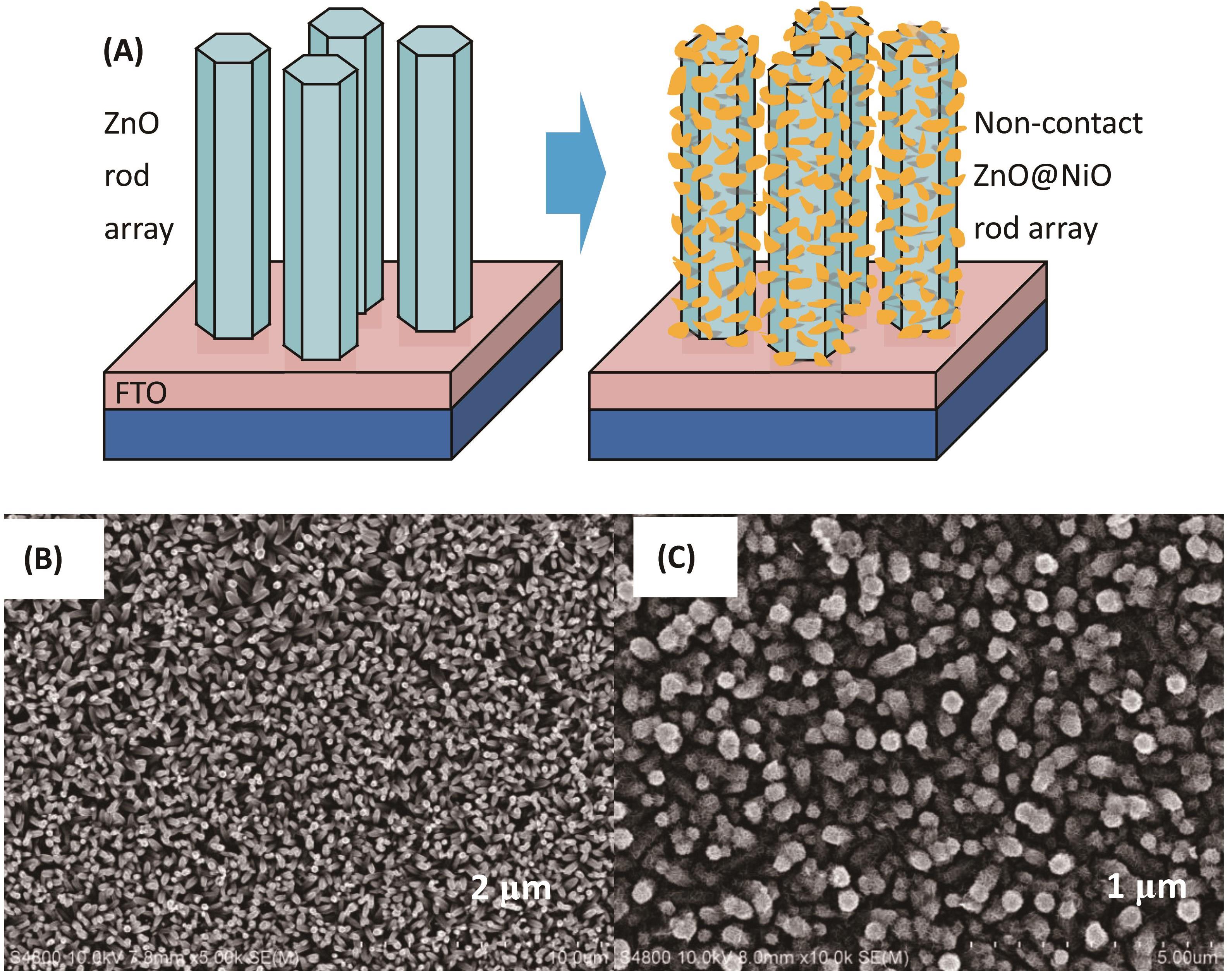
图5 非接触型ZnO-NiO核壳复合棒阵列膜的构筑示意图(A)、 ZnO棒阵列膜(B)和ZnO-NiO核壳复合棒阵列膜(C)的SEM照片[41]
Fig.5 Schematic diagram of the construction process of the ZnO-NiO film with non-contact core-shell rod array structure (A); SEM images of the ZnO rod array film (B) and ZnO-NiO core-shell rod array film (C) [41]

图7 In2O3棒阵列(A)和Ni(OH)2-In2O3复合膜(B)的SEM照片; FTO和In2O3的能带位置图(C); FTO/In2O3异质结界面能带图(D)[49]
Fig.7 SEM images of In2O3 rod array (A) and Ni(OH)2-In2O3 rod composite film (B); Energy band position diagram of FTO and In2O3 (C); Diagrams of FTO/In2O3 heterojunction (D)[49]
复合材料 Composite materials | 着色时间/ 消色时间 Coloration time(s)/ Bleaching time(s) | 着色效率 Coloration efficiency /(cm2·C-1) | 光学调制 (考查波长) Light modulation/% (Wavelength/nm) | 循环次数 Cycle index | 参考文献 Refs |
|---|---|---|---|---|---|
| NiO?ZnO | 2.6/9.7 | 78.5 | 81.0 (550) | - | [ |
ZnO?NiO棒阵列 ZnO?NiO rod array | <1 | <1 | - | 12 000 | [ |
| WO3?Ag | 3.9/8.9 | 90.2 | 40.6 (633) | - | [ |
| CuWO4?WO3 | 1.9/1.6 | 74.4 | 54.6 (800) | - | [ |
| WO3?ITO | 5.7/0.9 | 35.8 | 53.6 (633) | - | [ |
| C?V2O5 | 3.6/3.1 | 89.3 | 45.8 (650) | 5 000 | [ |
| MoO3?V2O5 | 8.2/6.3 | - | 31.4 (700) | - | [ |
| V2O5?GO | 1.4/2.5 | - | 40.9 (415) | - | [ |
NiO?普鲁士蓝 NiO?Prussian blue | 5.0/6.0 | 141.0 | 46.0 (700) | - | [ |
| NiO?TiO2 | 3.8/4.0 | 147.6 | 71.0 (550) | 3 000 | [ |
NiO?多壁碳纳米管 NiO?MWCNT | 8.1/6.6 | 31.1 | - | 5 000 | [ |
| NiO?rGO | 4.3/3.9 | 12.9 | 40.7 (550) | 1 000 | [ |
TiO2?普鲁士蓝 TiO2?Prussian blue | 6.2/2.2 | 131.5 | 48.0 (700) | - | [ |
| TiO2?Co3O4 | - | 91.0 | 40.0 (423) | 5 000 | [ |
| Ni?NiO?rGO | 4.2/2.4 | 48.2 | 51.6 (550) | - | [ |
V2O5?石墨烯 V2O5?graphene | - | 555.8 | 68.9 (800) | - | [ |
| WO3?rGO | 4.7/4.5 | 181.5 | 58.8 (633) | 2 500 | [ |
| WO3?MoO3 | 25.0/25.0 | 91.0 | 57.0 (650) | - | [ |
| WO3?TiO2 | 3.0/1.1 | 102.1 | 85.3 (633) | 3 000 | [ |
| Ni(OH)2?TiO2 | 0.4/1.2 | 95.3 | 89.0(550) | 11 000 | [ |
| In2O3?Ni(OH)2 | 8.0/3.0 | 101.4 | 61.6(550) | 6 500 | [ |
表1 2016年-2021年采用不同复合方式制得的无机-无机复合EC材料的性能
Table 1 EC properties of inorganic?inorganic composite materials obtained by different methods from 2016 to 2021
复合材料 Composite materials | 着色时间/ 消色时间 Coloration time(s)/ Bleaching time(s) | 着色效率 Coloration efficiency /(cm2·C-1) | 光学调制 (考查波长) Light modulation/% (Wavelength/nm) | 循环次数 Cycle index | 参考文献 Refs |
|---|---|---|---|---|---|
| NiO?ZnO | 2.6/9.7 | 78.5 | 81.0 (550) | - | [ |
ZnO?NiO棒阵列 ZnO?NiO rod array | <1 | <1 | - | 12 000 | [ |
| WO3?Ag | 3.9/8.9 | 90.2 | 40.6 (633) | - | [ |
| CuWO4?WO3 | 1.9/1.6 | 74.4 | 54.6 (800) | - | [ |
| WO3?ITO | 5.7/0.9 | 35.8 | 53.6 (633) | - | [ |
| C?V2O5 | 3.6/3.1 | 89.3 | 45.8 (650) | 5 000 | [ |
| MoO3?V2O5 | 8.2/6.3 | - | 31.4 (700) | - | [ |
| V2O5?GO | 1.4/2.5 | - | 40.9 (415) | - | [ |
NiO?普鲁士蓝 NiO?Prussian blue | 5.0/6.0 | 141.0 | 46.0 (700) | - | [ |
| NiO?TiO2 | 3.8/4.0 | 147.6 | 71.0 (550) | 3 000 | [ |
NiO?多壁碳纳米管 NiO?MWCNT | 8.1/6.6 | 31.1 | - | 5 000 | [ |
| NiO?rGO | 4.3/3.9 | 12.9 | 40.7 (550) | 1 000 | [ |
TiO2?普鲁士蓝 TiO2?Prussian blue | 6.2/2.2 | 131.5 | 48.0 (700) | - | [ |
| TiO2?Co3O4 | - | 91.0 | 40.0 (423) | 5 000 | [ |
| Ni?NiO?rGO | 4.2/2.4 | 48.2 | 51.6 (550) | - | [ |
V2O5?石墨烯 V2O5?graphene | - | 555.8 | 68.9 (800) | - | [ |
| WO3?rGO | 4.7/4.5 | 181.5 | 58.8 (633) | 2 500 | [ |
| WO3?MoO3 | 25.0/25.0 | 91.0 | 57.0 (650) | - | [ |
| WO3?TiO2 | 3.0/1.1 | 102.1 | 85.3 (633) | 3 000 | [ |
| Ni(OH)2?TiO2 | 0.4/1.2 | 95.3 | 89.0(550) | 11 000 | [ |
| In2O3?Ni(OH)2 | 8.0/3.0 | 101.4 | 61.6(550) | 6 500 | [ |
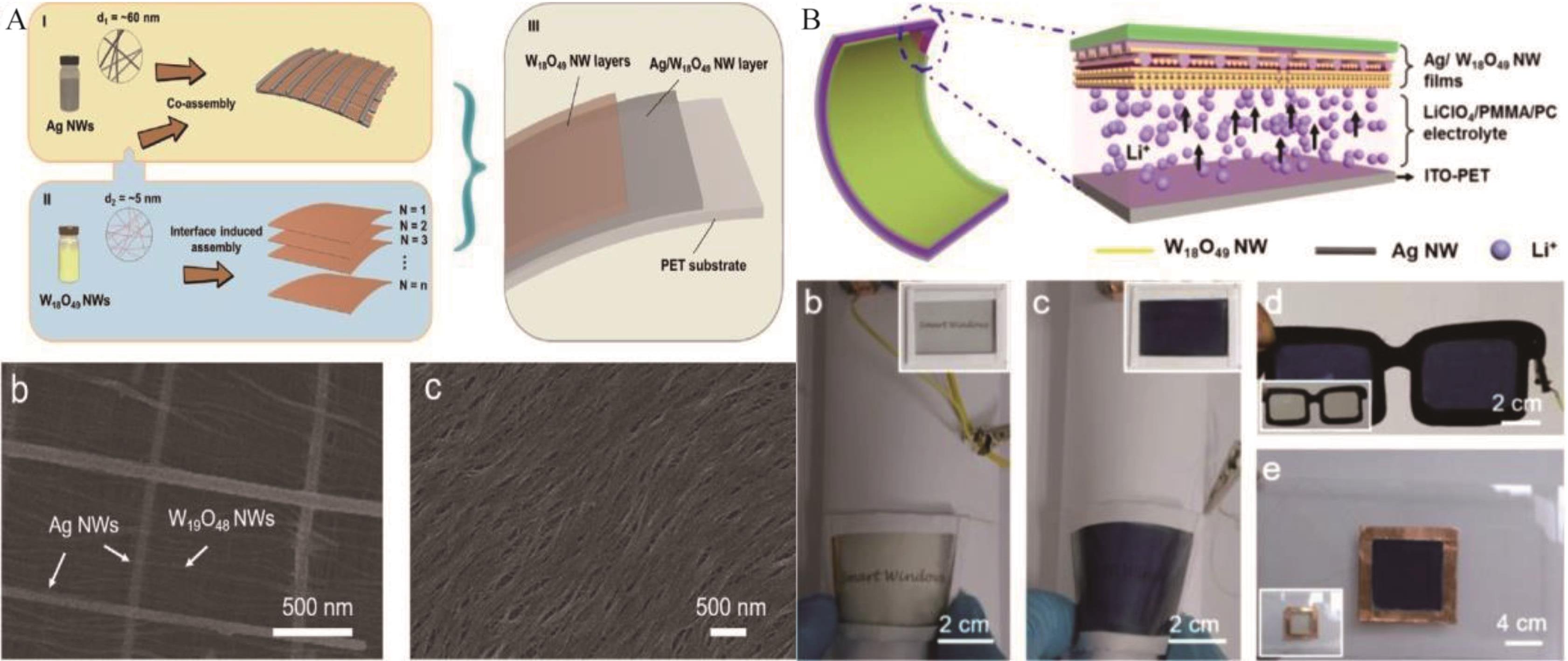
图9 (A)柔性透明电极的结构示意图(a)以及在聚对苯二甲酸乙二酯(PET)基底上共组装的Ag/W18O49纳米线网络的SEM照片(b-c)。 (B)固体EC器件的结构示意图(a); 在消色和着色态时弯曲器件的照片(b-c),插图为未弯曲器件的照片; EC眼镜模型的照片(d); EC灵巧窗模型的照片[74]
Fig.9 (A) Schematic illustration for the fabrication of flexible transparent electrodes (a) and SEM images of the co-assembled Ag/W18O49 NWs networks on the polyethylene terephthalate (PET) substrate (b-c). (B) Structural schematic diagram of solid electrochromic device (a) and Photographs of the bleached and colored state of solid electrochromic devices at bending state (b-c). The insets are photographs of the devices without bending. (d) Photographs of the electrochromic glasses model. (e) Photographs of the electrochromic window model[74]

图10 (A)EC器件的截面SEM照片; (B)400 ℃热处理所制备器件的透光率谱[75]
Fig.10 (A) Cross-sectional SEM image of EC device; (B) Transmittance spectra of the device prepared at annealing temperature of 400 ℃[75]
| 1 | THOMPSON B C, SCHOTTLAND P, ZONG K W, et al. In situ colorimetric analysis of electrochromic polymers and devices[J]. Chem Mater, 2000, 12: 1563-1571. |
| 2 | PLATT J R. Electrochromism, a possible change of color producible in dyes by an electric field[J]. J Chem Phys, 1961, 34: 862-863. |
| 3 | DEB S K. A novel electrophotographic system[J]. Appl Optics, 1969, 8: 192-195. |
| 4 | GUERFI A, PAYNTER R W, DAO L H. Characterization and stability of electrochromic MoO3 thin-films prepared by electrodeposition[J]. J Electrochem Soc, 1995, 142: 3457-3464. |
| 5 | MONK P M S, ALI T, PARTRIDGE R D. The effect of doping electrochromic molybdenum oxide with other metal-oxides-correlation of optical and kinetic-properties[J]. Solid State Ionics, 1995, 80: 75-85. |
| 6 | SEO S, LEE M J, SEO D H, et al. Reproducible resistance switching in polycrystalline NiO films[J]. Appl Phys Lett, 2004, 85: 5655-5657. |
| 7 | ANISIMOV V I, SOLOVYEV I V, KOROTIN M A, et al. Density-functional theory and NiO photoemission spectra[J]. Phys Rev B, 1993, 48: 16929-16934. |
| 8 | GHICOV A, TSUCHIYA H, HAHN R, et al. TiO2 nanotubes: H+ insertion and strong electrochromic effects[J]. Electrochem Commun, 2006, 8: 528-532. |
| 9 | KOELSCH M, CASSAIGNON S, GUILLEMOLES J F, et al. Comparison of optical and electrochemical properties of anatase and brookite TiO2 synthesized by the sol-gel method[J]. Thin Solid Films, 2002, 403: 312-319. |
| 10 | KANG E T, NEOH K G, TAN K L. Polyaniline: a polymer with many interesting intrinsic redox states[J]. Prog Polym Sci, 1998, 23: 277-324. |
| 11 | WANG Y G, LI H Q, XIA Y Y. Ordered whiskerlike polyaniline grown on the surface of mesoporous carbon and its electrochemical capacitance performance[J]. Adv Mater, 2006, 18: 2619-2623. |
| 12 | BEEK W J E, WIENK M M, JANSSEN R A J. Hybrid solar cells from regioregular polythiophene and ZnO nanoparticles[J]. Adv Funct Mater, 2006, 16: 1112-1116. |
| 13 | KLINE R J, MCGEHEE M D, TONEY M F. Highly oriented crystals at the buried interface in polythiophene thin-film transistors[J]. Nat Mater, 2006, 5: 222-228. |
| 14 | MENON V P, LEI J T, MARTIN C R. Investigation of molecular and supermolecular structure in template-synthesized polypyrrole tubules and fibrils[J]. Chem Mater, 1996, 8: 2382-2390. |
| 15 | CHEN G Z, SHAFFER M S P, COLEBY D, et al. Carbon nanotube and polypyrrole composites: coating and doping[J]. Adv Mater, 2000, 12: 522-526. |
| 16 | CAI G F, EH A L S, JI L, et al. Recent advances in electrochromic smart fenestration[J]. Adv Sustain Syst, 2017, 1: 1700074. |
| 17 | 苑晓, 贺泽民, 张兰英, 等. 电致变色材料研究及发展现状[J]. 新材料产业, 2014, 5: 14-18. |
| YAN X, HE Z M, ZHANG L Y, et al. Research and development status of electrochromic materials[J]. Adv Mater Ind, 2014, 5: 14-18. | |
| 18 | 孙宁, 赵灵芝, 张玉杰. 电致变色薄膜研究进展[J]. 中国陶瓷, 1998, 5: 34-37. |
| SUN N, ZHAO L Z, ZHANG Y J. Advance in electrochromic films[J]. China Ceram, 1998, 5: 34-37. | |
| 19 | WEI Y X, ZHOU J L, ZHENG J M, et al. Improved stability of electrochromic devices using Ti-doped V2O5 film[J]. Electrochim Acta, 2015, 166: 277-284. |
| 20 | PURUSHOTHAMAN K K, MURALIADHARAN G. The effect of annealing temperature on the electrochromic properties of nanostructured NiO films[J]. Sol Energy Mater Sol Cells. 2009, 93: 1195-1201. |
| 21 | ZRIKEM K, SONG G, AGHZZAF A A, et al.UV treatment for enhanced electrochromic properties of spin coated NiO thin films[J]. Superlattice Microst, 2019, 127: 35-42. |
| 22 | 王金敏, 后丽君, 马董云. 氧化钼电致变色材料与器件[J]. 无机材料学报, 2021, 36(5): 461-470. |
| WANG J M, HOU L J, MA D Y. Molybdenum oxide electrochromic materials and devices[J]. J Inorg Mater, 2021, 36(5): 461-470. | |
| 23 | REN Y, CHIM W K, GUO L, et al. The coloration and degradation mechanisms of electrochromic nickel oxide[J]. Sol Energy Mater Sol Cells, 2013, 116: 83-88. |
| 24 | XIE Z, LIU Q, ZHANG Q, et al. Fast-switching quasi-solid state electrochromic full device based on mesoporous WO3 and NiO thin films[J]. Sol Energy Mater Sol Cells, 2019, 200: 110017. |
| 25 | XIE Z, LIU Q, LU B, et al. Large coloration efficiency and fast response NiO electrochromic thin film electrode based on NiO nanocrystals[J]. Mater Today Commun, 2019, 21: 100635. |
| 26 | FIRAT Y E, PEKSOZ A. Efficiency enhancement of electrochromic performance in NiO thin film via Cu doping for energy-saving potential[J]. Electrochim Acta, 2019, 295: 645-654. |
| 27 | 成明, 杨继凯, 杨馥瑜, 等. WO3/TiO2复合薄膜的制备及其电致变色性能[J]. 复合材料学报, 2019, 36(4): 914-920. |
| CHENG M, YANG J K, YANG F Y, et al. Preparation and electrochromic properties of WO3/TiO2 composite films[J]. Acta Mater Compos Sin, 2019, 36(4): 914-920. | |
| 28 | TANG K, ZHANG Y, SHI Y D, et al. Fabrication of WO3/TiO2 core-shell nanowire arrays: structure design and high electrochromic performance[J]. Electrochim Acta, 2020, 330: 135189. |
| 29 | WANG Z X, WANG H, GU X, et al. Hierarchical structure WO3/TiO2 complex film with enhanced electrochromic performance[J]. Solid State Ionics, 2019, 338: 168-176. |
| 30 | XIONG S X, YIN S Y, WANG Y Y, et al. Organic/inorganic electrochromic nanocomposites with various interfacial interactions: a review[J]. Mater Sci Eng B: Adv, 2017, 221: 41-53. |
| 31 | REYES-GIL K R, STEPHENS Z D, STAVILA V, et al. Composite WO3/TiO2 nanostructures for high electrochromic activity[J]. ACS Appl Mater Inter, 2015, 7: 2202-2213. |
| 32 | 刘雪晴, 钟晓岚, 刁训刚. 氧化镍基电致变色薄膜与器件研究进展[J]. 真空与低温, 2020, 5: 345-360. |
| LIU X Q, ZHONG X L, DIAO X G. Advances in electrochromic films and devices based on nickel oxide[J]. Vacuum Cryogenics, 2020, 5: 345-360. | |
| 33 | YU J H, YANG H, JUNG R H, et al. Hierarchical NiO/TiO2 composite structures for enhanced electrochromic durability[J]. Thin Solid Films, 2018, 664: 1-5. |
| 34 | BO G S, WANG X, WANG K, et al. Preparation and electrochromic performance of NiO/TiO2 nanorod composite film[J]. J Alloy Compd, 2017, 728: 878-886. |
| 35 | QI X Y, SU G, BO G S, et al. Synthesis of NiO and NiO/TiO2 films with electrochromic and photocatalytic activities[J]. Surf Coat Tech, 2015, 272: 79-85. |
| 36 | CAI G F, TU J P, ZHOU D, et al. Constructed TiO2/NiO core/shell nanorod array for efficient electrochromic application[J]. J Phys Chem C, 2014, 118: 6690-6696. |
| 37 | 亢嘉琪, 杨继凯, 杨馥瑜, 等. TiO2/MoO3复合薄膜的制备及其电致变色性能研究[J]. 光子学报, 2018, 47(3): 75-83. |
| KANG J Q, YANG J K, YANG F Y, et al. Preparation and electrochromic properties of TiO2/MoO3 composite film[J]. Acta Photonic Sin, 2018, 47(3): 75-83. | |
| 38 | XU H B, GONG L T, ZHOU S Y, et al. Enhancing the electrochromic stability of prussian blue based on TiO2 nanorod arrays[J]. New J Chem, 2020, 44: 2236-2240. |
| 39 | WANG X, LIU B, TANG J, et al.Preparation of Ni(OH)2 /TiO2 porous film with novel structure and electrochromic property[J]. Sol Energy Mater Sol Cells, 2019, 191: 108-116. |
| 40 | WEI W, GU X Y, LIU Y Z, et al. Three-dimensional structures of nanoporous NiO/ZnO nanoarray films for enhanced electrochromic performance[J]. Chem-Asian J, 2019, 14: 431-437. |
| 41 | TAN S J, GAO L, WANG W Q, et al. Preparation and black-white electrochromic performance of the non-contact ZnO@NiO core-shell rod array[J]. Surf Interfaces, 2022, 30: 101889. |
| 42 | KOO B R, BAE J W, AHN H J. Percolation effect of V2O5 nanorod/graphene oxide nanocomposite films for stable fast-switching electrochromic performances[J]. Ceram Int, 2019, 45: 12325-12330. |
| 43 | LANG F P, LIU J B, WANG H, et al. NiO nanocrystalline/reduced graphene oxide composite film with enhanced electrochromic properties[J]. Nano, 2017, 12: 1750058. |
| 44 | WU J, QIU D, ZHANG H L, et al. Flexible electrochromic V2O5 thin films with ultrahigh coloration efficiency on graphene electrodes[J]. J Electrochem Soc, 2018, 165: D183-D189. |
| 45 | KHAN A, BHOSALE N Y, MALI S S, et al, Reduced graphene oxide layered WO3 thin film with enhanced electrochromic properties[J]. J Colloid Interf Sci, 2020, 571: 185-193. |
| 46 | THONGPAN W, LOULOUDAKIS D, POOSEEKHEAW P, et al. Porous CuWO4/WO3 composite films with improved electrochromic properties prepared by sparking method[J]. Mater Lett, 2019, 257: 126747. |
| 47 | LIU Y, YUAN G Z, HUA C Z, et al. Improvement of electrochromic performance by embedding ITO nanocrystals in amorphous WO3 film[J]. Ecs J Solid State Sc, 2019, 8: P1-P6. |
| 48 | GARCIA-LOBATO M A, GARCIA C R, MTZ-ENRIQUEZ A I, et al. Enhanced electrochromic performance of NiO-MWCNTs thin films deposited by electrostatic spray deposition[J]. Mater Res Bull, 2019, 114: 95-100. |
| 49 | WANG W Q, LI Z X, YU Z F, et al. The stabilization of Ni(OH)2 by In2O3 rods and the electrochromic performance of Ni(OH)2/In2O3-rod composite porous film[J]. Thin Solid Films, 2021, 734: 138839. |
| 50 | NAJAFI-ASHTIANI H, BAHARI A, GHOLIPOUR S. Investigation of coloration efficiency for tungsten oxide-silver nanocomposite thin films with different surface morphologies[J]. J Mater Sci-Mater El, 2018, 29: 5820-5829. |
| 51 | HSIAO Y S, CHANG-JIAN C W, SYU W L, et al. Enhanced electrochromic performance of carbon-coated V2O5 derived from a metal-organic framework[J]. Appl Surf Sci, 2021, 542: 148498. |
| 52 | CHANG C C, CHI P W, CHANDAN P, et al. Electrochemistry and rapid electrochromism control of MoO3/V2O5 hybrid nanobilayers[J]. Materials, 2019, 12: 2475. |
| 53 | 岳言芳, 李海增, 李克睿, 等. NiO/PB复合电致变色薄膜的制备及其性能研究[J]. 无机材料学报, 2017, 32(9): 949-954. |
| YUE Y F, LI H Z, LI K R. et al. Preparation and properties of NiO/PB hybrid electrochromic film[J]. J Inorg Mater, 2017, 32(9): 949-954. | |
| 54 | CHEN Y B, BI Z J, LI X M, et al. High-coloration efficiency electrochromic device based on novel porous TiO2@prussian blue core-shell nanostructures[J]. Electrochim Acta, 2017, 224: 534-540. |
| 55 | MISHRA S, YOGI P, SAGDEO P R, et al. TiO2-Co3O4 core-shell nanorods: bifunctional role in better energy storage and electrochromism[J]. ACS Appl Energ Mater, 2018, 1: 790-798. |
| 56 | JIANG S S, YUAN G Z, HUA C Z, et al. Electrochromic properties of Ni/NiO/rGO nanocomposite films prepared by a facile sol-gel technique[J]. J Electrochem Soc, 2017, 164: H896-H902. |
| 57 | JITTIARPORN P, SIKONG L, KOOPTARNOND K, et al. Electrochromic properties of MoO3-WO3 thin films prepared by asol-gel method, in the presence of atriblock copolymer template[J]. Surf Coat Tech, 2017, 327: 66-74. |
| 58 | GRANQVIST C G. Electrochromics for smart windows: oxide-based thin films and devices[J]. Thin Solid Films, 2014, 564: 1-38. |
| 59 | SVENSSON J, GRANQVIST C G. Electrochromic coatings for “smart windows”[J]. Sol Energy Mater Sol Cells, 1985, 12(6): 391-402. |
| 60 | THAKUR V K, DING G Q, MA J, et al. Hybrid materials and polymer electrolytes for electrochromic device applications[J]. Adv Mater, 2012, 24(30): 4071-4096. |
| 61 | SHIMIZU Y, FURUTA S. An opto-electrochemical phosphate-ion sensor using a cobalt-oxide thin-film electrode[J]. Solid State Ionics, 1998, 113/114/115: 241-245. |
| 62 | MELVILLE O A, LESSARD B H, BENDER T P. Phthalocyanine-based organic thin-film transistors: areview of recent advances[J]. ACS Appl Mater Interfaces, 2015, 7: 13105-13118. |
| 63 | IBARAKI N, KOMAKI T, KIMURA M. Introduction special section based on presentations from the 18th international display workshops (IDW '11) [J]. J Soc Inf Display, 2012, 20: 485-485. |
| 64 | HALL D S, LOCKWOOD D J, BOCK C, et al. Nickel hydroxides and related materials: a review of their structures, synthesis and properties[J]. P Roy Soc A:Math Phy Sci, 2015, 471(2174): 65. |
| 65 | 张旭苹. 电致变色灵巧窗的设计与研制[J]. 太阳能学报, 1997, 18(4): 415-420. |
| ZHANG X P. The design and preparation of electrochromic smart windows[J]. Acta Energiae Solaris Sin, 1997, 18(4): 415-420. | |
| 66 | 冯博学, 陈冲, 何毓阳, 等.电致变色材料及器件的研究进展[J]. 功能材料, 2004, 35(2): 145-150. |
| FENG B X, CHEN C, HE Y Y, et al. Advance in research on electrochromic materials and devices[J]. J Funct Mater, 2004, 35(2): 145-150. | |
| 67 | ATAK G, COSKUN O. Fabrication of an all solidstate electrochromic device using zirconium dioxide as an ion-conducting layer[J]. Thin Solid Films, 2018, 664: 70-78. |
| 68 | COSKUN O, ATAK G. The effects of lithiation process on the performance of all-solid-state electrochromic devices[J]. Thin Solid Films, 2018, 662: 13-20. |
| 69 | 张旭苹, 陈国平. 电致变色智能玻璃研究的现状[J]. 新型建筑材料, 1995(9): 16-20. |
| ZHANG X P, CHEN G P. The advances of electrochromic smart glass[J]. New Building Mater, 1995(9): 16-20. | |
| 70 | SONG X W, DONG G B, GAO F Y, et al. Properties of NiOx and its influence upon all-thin-film ITO/NiOx/LiTaO3/WO3/ITO electrochromic devices prepared by magnetron sputtering[J].Vacuum, 2015, 111: 48-54. |
| 71 | ZHANG X P, ZHANG H K, LI Q, et al. An all-solid-state inorganic electrochromic display of WO3 and NiO films with LiNbO3 ion conductor[J]. IEEE Electron Device Lett, 2000, 21(5): 215-217. |
| 72 | 崔敏慧, 吴正华, 邱思畴, 等. 聚氧乙烯-高氯酸锂配合物电致变色光窗的研究[J]. 应用化学, 1996, 13(6): 39-41. |
| CUI M H, WU Z H, QIU S C, et al. Electrochromic window based on polyoxyethylene-lithium perchlorate complex[J]. Chinese J Appl Chem, 1996, 13(6): 39-41. | |
| 73 | YU H F, KAOA S Y, LUA H C. Electrospun nanofibers composed of poly(vinylidenefluoride-co-hexafluoropropylene) and poly(oxyethylene)-imide imidazolium tetrafluoroborate as electrolytes for solid-state electrochromic devices[J]. Sol Energy Mater Sol Cells, 2018, 177: 32-43. |
| 74 | WANG J L, LU Y R, LI H H, et al. Large area co-assembly of nanowires for flexible transparent smart windows[J]. J Am Chem Soc, 2017, 139: 99219926. |
| 75 | LI W J, ZHANG X, CHEN X, et al. Long life all-solid-state electrochromic devices by annealing[J]. Sol Energy Mater Sol Cells, 2021, 224: 110992. |
| 76 | ZHAO Y M, ZHANG X, CHEN X, et al. Preparation of Sn-NiO films and all-solid-state devices with enhanced electrochromic properties by magnetron sputtering method[J]. Electrochim Acta, 2021, 367: 137457. |
| [1] | 周嘉成, 王冬冬, 高云宝, 金晶, 姜伟. 基于聚二氧化碳树脂压敏胶的流变及粘结性能[J]. 应用化学, 2023, 40(6): 871-878. |
| [2] | 胡杏梅, 张锦鸿, 莫玉琳, 林海彬. 基于牛血清白蛋白与席夫碱的组合而构建出双输出分子逻辑电路[J]. 应用化学, 2023, 40(6): 904-915. |
| [3] | 王路飞, 甄蒙蒙, 沈伯雄. 贫电解液下电催化剂对调控锂硫电池性能的研究进展[J]. 应用化学, 2023, 40(2): 188-209. |
| [4] | 石雪建, 刘万强, 王春丽, 程勇, 王立民. 钾离子电池用Sb基负极材料研究进展[J]. 应用化学, 2023, 40(2): 210-228. |
| [5] | 熊玉华, 周蕾, 杨世忠, 牟伯中. 低温β-甘露聚糖酶的酶学性质及破胶性能[J]. 应用化学, 2023, 40(1): 134-145. |
| [6] | 林渊, 陈嘉炼, 李红周. 单宁酸/聚乙烯醇的阻燃性能[J]. 应用化学, 2023, 40(1): 69-78. |
| [7] | 柳小虎, 赖小娟, 曹红燕, 王婷婷, 党志强. 起泡剂/稳泡剂/SiO2复合泡沫缓速酸液体系协同增效性能[J]. 应用化学, 2023, 40(1): 91-99. |
| [8] | 张丹, 刘芳, 杨雪, 许东华, 石彤非. 热塑性聚氨酯共混物的硬度与冲击性能的关系[J]. 应用化学, 2022, 39(8): 1216-1223. |
| [9] | 孟玉, 张晴, 彭文浩, 朱晓飞, 周德凤. Pr0.8Sr0.2Fe0.7Ni0.3O3-δ -Pr1.2Sr0.8Ni0.6Fe0.4O4+δ 复合阴极的制备及其电化学性能[J]. 应用化学, 2022, 39(5): 797-808. |
| [10] | 董国华, 郝丽娟, 张文治, 柴东凤, 赵明, 郎坤. 碳量子点纳米材料在铅卤钙钛矿太阳能电池中的应用研究进展[J]. 应用化学, 2022, 39(5): 707-722. |
| [11] | 郭晓峰, 李佳林, 王宇博, 金君素. 含硫高折射率光学树脂合成及性能研究进展[J]. 应用化学, 2022, 39(5): 723-735. |
| [12] | 周晶, 陈俞萱, 马焌铭, 朱晓飞, 周德凤. MgO和Fe2O3的添加对GDCSi体系微观结构及电化学性能的影响[J]. 应用化学, 2022, 39(5): 809-818. |
| [13] | 张琦, 张乾, 师晓梦, 孔娅淇, 高可心, 杜亚平. 稀土溴化物固态电解质材料在全固态电池中的应用研究进展[J]. 应用化学, 2022, 39(4): 585-598. |
| [14] | 吕永鹏, 王玉阁, 谷倩倩, 张之材, 肖建数, 尹园, 孙洪国, 郑雅芳, 孙昭艳. 炭黑在异戊橡胶中的分散及其对动静态性能的影响[J]. 应用化学, 2022, 39(12): 1842-1853. |
| [15] | 唐永鑫, 聂立武. 环氧树脂掺量对发光树脂透水混凝土性能的影响[J]. 应用化学, 2022, 39(11): 1665-1671. |
| 阅读次数 | ||||||
|
全文 |
|
|||||
|
摘要 |
|
|||||
